📌 Sara El Kabiri, Federal Office for Spatial Development ARE: public policies for mobility in Switzerland
📌 Sara El Kabiri, Federal Office for Spatial Development ARE: public policies for mobility in Switzerland
An expert on mobility of the future at the Federal Office for Spatial Development ARE, Sara El Kabiri presents an overview of Swiss transport policy, from the 19th century to today’s prospective studies and associated transport development plans.
Futura-Mobility: How is transport management organised in Switzerland?
Sara El Kabiri: At federal level, the Department of the Environment, Transport, Energy and Communications (DETEC) looks after both infrastructure (modern traffic routes, electricity and communications networks) and the environment. It must also take into account requirements linked to health and safety.
Within it, several offices work on transport & mobility issues: the Federal Office of Transport for road and rail public transport; the Federal Roads Office for national highway infrastructure; the Federal Office of Energy for electric mobility and shared mobility; the Federal Office of Civil Aviation, and the Federal Office for Spatial Development (ARE), where I am attached.
ARE is the office responsible, in particular, for coordinating mobility at DETEC level, and for coordinating between territorial planning and transport policy. In particular, in partnership with the stakeholders concerned, it draws up the framework for territorial planning, transport and sustainable development policies. It is also in charge of the programme for agglomeration transport.
FM: Switzerland is known for its impressive rail network. What were the major milestones when developing this mode of transport in Switzerland?
SEK: Let’s go back to the 19th century. The first train to run on Swiss soil was called the “Napoléon”, a French train! From 1844, it ran for 2 km on Swiss territory on the 130 km Strasbourg-Basle line. Then, in 1847, the first railway line to run entirely on Swiss soil, between Zurich and Baden, opened. It totalled 25 km and included Switzerland’s first railway tunnel, 90 metres long, near Baden. However, compared to other European countries such as Germany and Belgium, Switzerland was rather behind in terms of railway development at this time; this can certainly be explained by its rugged terrain, cultural diversity, and around 400 inland customs posts!
The year 1858 marked the first end-to-end mountain breakthrough in the Swiss Jura. Then the focus turned to crossing the Alps to position Switzerland on trans-European routes. In 1882, the 15km Gotthard ridge tunnel was inaugurated, followed by the Simplon tunnel in 1906 and the Lötschberg tunnel in 1913. There was a great deal of innovation at the time, with cutting-edge tunnel boring machines, for instance.
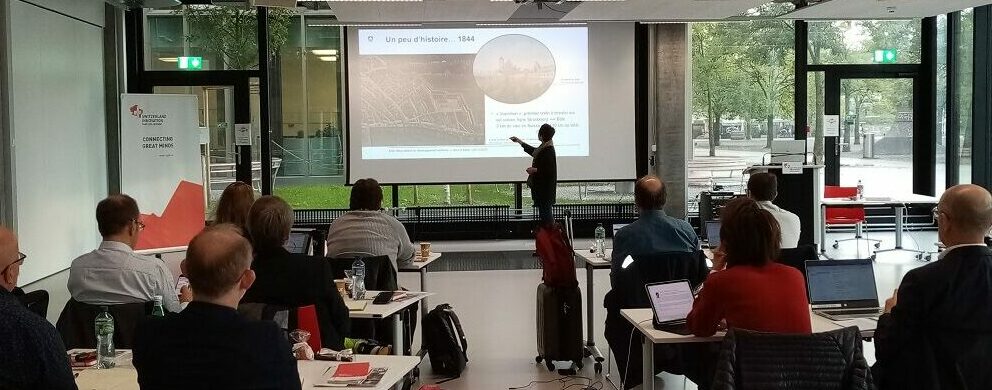
FM: Yet didn’t Switzerland quickly catch up with the railways and become a pioneer in certain areas?
SEK: Indeed, in the 1870s, with the Franco-Prussian war and the economic crisis known as the ‘Great Depression’, the many small private railway companies found themselves in financial difficulties and national security issues began to make themselves felt. Thus in 1898, following a popular vote, Swiss railways were nationalised, giving rise in 1902 to Swiss Federal Railways (SBB). This made Switzerland a pioneer in railway nationalisation!
Switzerland was also a pioneer in electrification: before World War II, almost 80% of its rail network was already electrified! It’s worth noting that, in addition to the coal shortage, there was poor public acceptance of the pollution generated by steam trains.
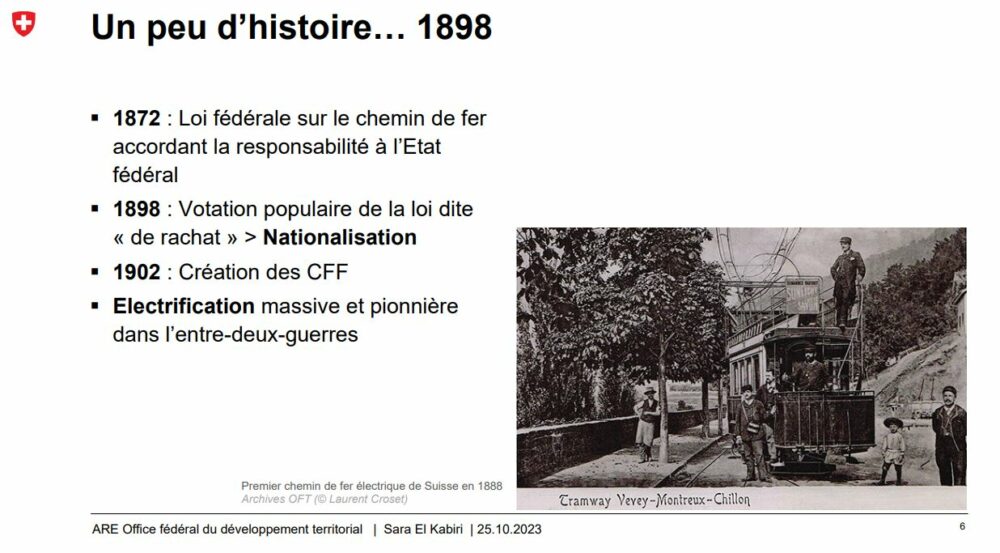
FM: What about the roads?
SEK: The first motorway opened in 1955. It had a pedestrian crossing and cyclists could use it! There was no speed limit. Even at that time, in a country sensitive to landscape, the Swiss were aware of the impact of infrastructure on the consumption of space.
FM: When were the first decisions taken to steer mobility towards more sustainable modes?
SEK: The 1980s marked the turning point in Swiss transport policy: the development of the car and road networks, synonymous with the abandonment of public transport, was called into question. It was time to establish a new balance. In 1987, the Swiss voted for a credit of over CHF 5 billion to set up Rail 2000, an ambitious project for modernising the Swiss rail network (stations, infrastructure, rolling stock) and improving passenger services (connections, hourly intervals, journey times). New financial envelopes were subsequently dedicated to densifying the railway network up until 2014, when a perennial fund for railway maintenance and investment (FIF) was created. Since 2018, a permanent fund (FORTA) also exists to finance the needs of the national road network (motorways), as well as traffic control measures in conurbations, i.e. developing public transport trunk roads and infrastructure for soft mobility.

These funds are financed annually by revenue from various taxes and remain entirely earmarked for transport infrastructure. So they contribute decisively towards stabilising and securing the running and development of the Swiss transport system.
Since 2001, for instance, there has been a tax on road services for heavy goods vehicles in Switzerland (RPLP), calculated according to vehicle weight, mileage and (pollutant) emission category. Due to this tax on road haulage, coupled with an efficient rail network, hauliers prefer rail: in Switzerland, 75% of transalpine freight travels by rail, whereas the proportions are reversed in neighboring countries!
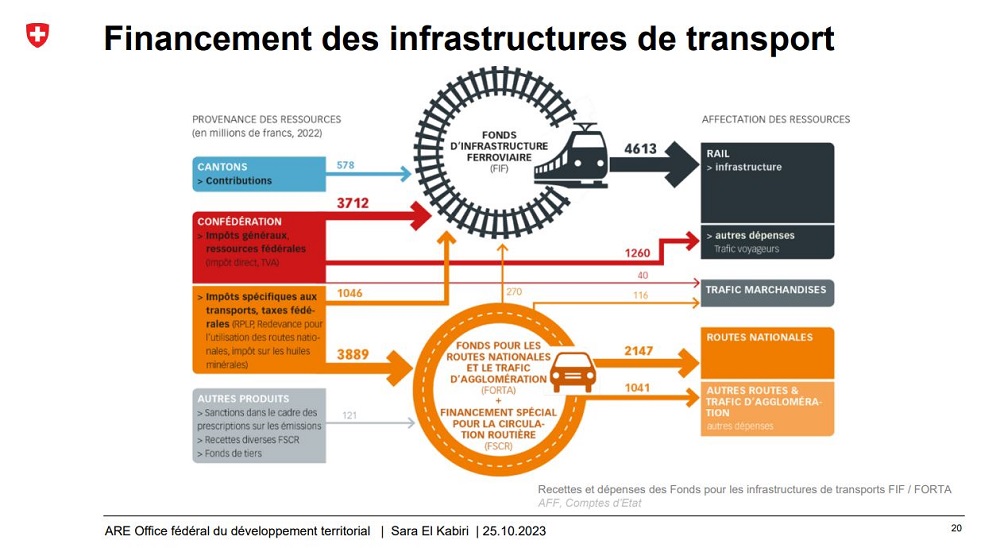
FM: How do you plan transport spending in Switzerland?
SEK: Transport infrastructure planning involves long cycles, lasting 20 years or more. At federal level, there are prospective and strategic orientation tools that provide a long-term vision for the territory, transport and sustainable development; and there is the sectoral transport plan, which realises the desired vision for the mobility system and is binding for the authorities.

The Swiss territorial project, Switzerland’s most important spatial planning tool, is currently being revised with a view to 2050. It provides an orientation framework and decision-making support for spatial planning policies at the three institutional levels: federal, cantonal and municipal. The emphasis is on concerted action between the various levels and stakeholders, preserving the assets and diversity of Switzerland’s 12 action areas and strengthening the polycentric network structure.
It’s important to know that in Switzerland, ‘ground’ as a resource is costly: over a third of the total surface area is farmland, another third is covered by forests and a quarter is unproductive (rocks, glaciers, etc). Housing and infrastructure account for only around 7% of the country. So spatial planning issues are crucial, also since demographics and the economy are growing. For this reason, Switzerland is focusing on high-quality densification within existing built-up areas. Transportation is an important lever for achieving this goal.
The second tool, the Transport outlooks, is a quantified forecasting and scenario-building exercise, also formulated for 2050 in the version released in 2021. These outlooks are regularly updated to allow for changes in society and technology. In the 2021 version, remote working, new forms of mobility (shared, automated driving) and new modes of delivery are taken into account alongside demographic and economic growth.
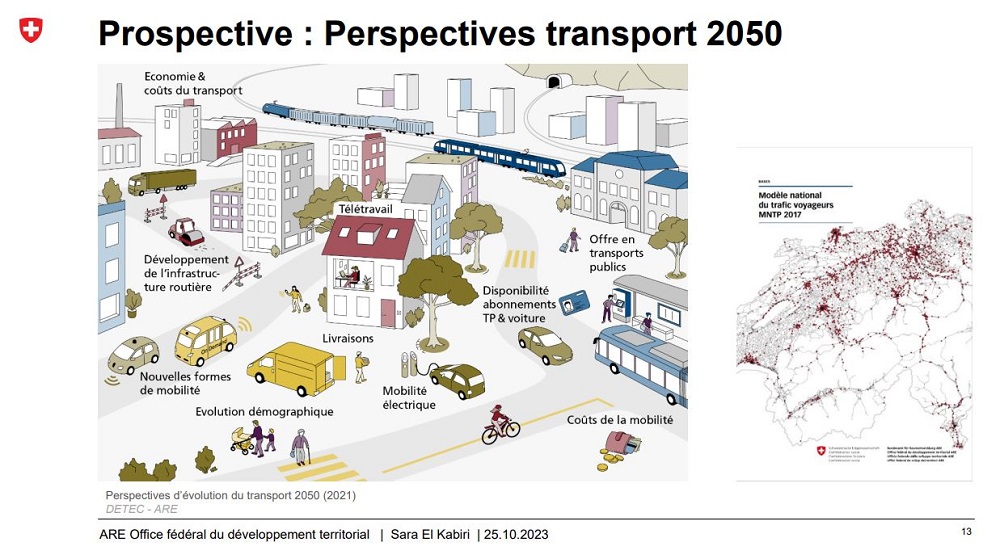
By studying several possible scenarios (‘status quo’, ‘sustainable society’, and ‘individualised society’) alongside a ‘baseline’ scenario [see illustration below], we assess the evolution of transport demand and increase in services by mode for people and goods. For instance, person-kilometres are forecast to increase by “only” 11% between 2017 and 2050, while the population will grow by 21%. Today, there are 8.7 million people in Switzerland; in the baseline scenario, there will be around 10.5 million in 2050. Population ageing, remote working, and the impacts of inward densification are some of the factors that explain this decoupling. With electrification of cars on the roads, modal shift needs to be stepped up in order to reach the climate neutrality now enshrined in law following a popular vote this year – 2023.
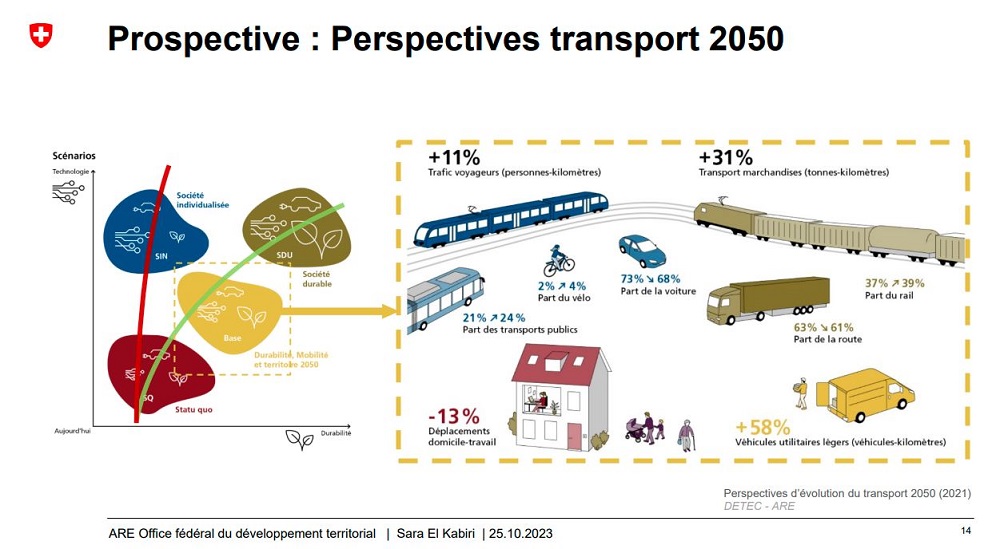
Finally, these reflections and strategic orientations have produce the Sectoral transport plan, which sets out the guiding framework for the entire sector, across all modes (rail, road, navigation, and aviation), for people and goods transport. It was revised in 2021 and is binding for the authorities at all levels. It aims to coordinate transport with the vision for territorial development and keep the environmental impacts as low as possible. For instance, among the conditions for efficiency, it sets out the principle of methodically exhausting all possible options for optimising available capacity before building any new infrastructure. Depending on the type of territory in question, the plan also provides principles for service standards and complementarity between modes – to guarantee the quality of transport links. In this plan, co-modality is a key principle: the right mode of transport in the right place to ensure efficiency and meet performance objectives.
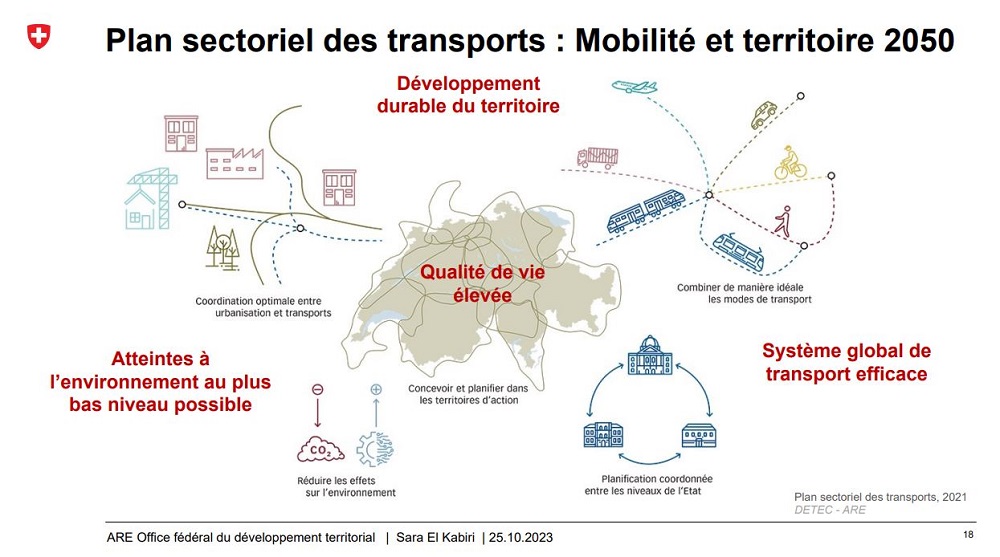
The Transport sectoral plan then provides a framework for infrastructure investment programmes (PRODES) and an agglomeration transport programme (PTA), which accommodate the infrastructure and planning measures developed by the cantons and communes, and which will be submitted to Parliament for approval to secure their financing by the FIF and FORTA funds.
FM: What are the main areas of research for transport of the future in Switzerland?
SEK: Research and innovation programmes are focused on sustainable mobility, shared mobility, multimodality, and interconnections between transport modes, electro-mobility, the impacts of demand and behaviour, automated driving… amongst other topics.
FM: And what about autonomous cars?
SEK: With regards automated driving, pilot tests have been deployed under various traffic conditions and in different forms since 2015, authorised by DETEC and the Federal Roads Office. In spring 2023, Parliament approved a revision of the Road Traffic Act to pave the way for deployment on the roads in Switzerland. In October 2023, the Federal Council put out to consultation two ordinances that set out the framework conditions for specific automated driving use applications, including lifting the ban on letting go of the steering wheel in certain circumstances for private vehicles, automated parking, and autonomous shuttles/minibuses operating outside the trial environment.



